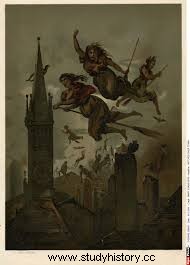
At the end of the Middle Ages, in 1486, appears Malleus Maleficarum , the first treatise on demonology. It is with the omnipresence of religion, and even of the Inquisition, that people's distrust of the Evil One grows. At a time when everything is justified by the Bible and the word of the priests, superstition is born in the absence of scientific explanations (such as medicine) and witchcraft applies more and more to the inexplicable. We only practice exorcism or the invocation of saints in a world where only theology answers to the name of science. Moreover, those rejected from the Church, or those who see her powerless, tend to turn to the powers of hell in opposition to a repressive religion.
We immediately speak of witchcraft or magic when a supernatural event occurs. According to the church, anything that relates to evil, and especially anything that offends God, is witchcraft. One of the best examples is that of heresy. But she also suspects the users of magic herbs, the triggers of storms, the incanters disturbing the minds of men by the invocation of demons, or the practitioners of nocturnal sacrifices in honor of the demons, as well as all those which could have any connection with Satan or his henchmen.
The stereotype of the old, poor, ugly, reclusive witch does not apply in the age of accusations of evil practices. A witch being able to be a neighbor of the village or a completely ordinary person, one quickly sees in the woman an association with Satan as soon as she appears temptress, pushing the man to sin; the one who plays a manipulative role and camouflages herself to better use witchcraft. Witches maintain the fear of misfortune (by incantations, charms, conjurations or other superstitious infamies, as well as excesses of magic):they are insatiable in the abominations spread around them.
